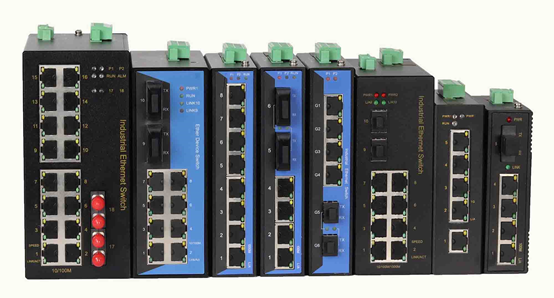Industrial Ethernet protocol has been developing rapidly and will mostly replace other traditional industrial protocol. Industrial manufacturing plants are also understanding the benefits of Industrial Ethernet in improving production efficiency, simplifying management, and consolidating information between production and management. However, Ethernet in industry has some differences compared to residential and office Ethernet. The automation engineer needs to be equipped with basic knowledge and understanding of industrial Ethernet to be able to successfully deploy. These are cable, signal quality, switch, ground loop and traffic.
1. Ethernet cable

Same as other industry networking protocol, Ethernet cables play an important role in signal and transmission quality. Different from the office or home environment, the industrial environment is a place with many electromagnetic interference signals, extreme conditions of temperature, humidity, dust and chemicals. Therefore, the choice of cable plays an important role in the deployment and operation of the network system.
So what type of cable is suitable? For an office environment, you can use CAT5e cable with a transmission speed of 100MB. For industrial environments, the ANSI/TIA-1005 standard recommends the use of CAT6 or higher cables. The CAT6 cable allows transmission speed up to 1GB at 100m and 10GB at 55m.
Compared with CAT5 and CAT5e cables, CAT6 is less impacted by electromagnetic and audio. In addition, CAT6 cables are also physically manufactured to be more suitable for industrial environments. However, when installing CAT6 cables, it should be noted that the RJ45 connectors, the jacks must also meet the CAT6 standard.
| Cable | Type | Bandwidth | Remark |
| Cat 3 | UTP | 16 MHz | Ethernet 10BASE-T and 100BASE-T4 |
| Cat 4 | UTP | 20 MHz | Token Ring 16Mbit/s |
| Cat 5 | UTP | 100 MHz | Ethernet 100BASE-TX & 1000BASE-T |
| Cat 5e | UTP | 100 MHz | Ethernet 100BASE-TX & 1000BASE-T |
| Cat 6 | STP | 250 MHz | Ethernet 10GBASE-T |
| Cat 6a | STP | 500 MHz | Ethernet 10GBASE-T |
| Cat 7 | STP | 600 MHz | Ethernet 10GBASE-T or POTS/CATV/1000BASE-T single |
| Cat 7a | STP | 1000 MHz | Ethernet 10GBASE-T or POTS/CATV/1000BASE-T single |
| Cat 8/8.1 | STP | 1600-2000 MHz | Ethernet 40GBASE-T or POTS/CATV/1000BASE-T single |
| Cat 8.2 | STP | 1600-2000 MHz | Ethernet 40GBASE-T or POTS/CATV/1000BASE-T single |
2. Switch

Switch is an important network device in Ethernet network system, used to connect terminal devices in the network.
In industrial Ethernet networks, there are three communication methods: Unicast, Multicast and Broadcast.
- Unicast is point-to-point communication, packets are sent only between two devices.
- Multicast is a method of communication between a device and a group of devices in the network.
- Broadcast is a method of communication between a device in the network and all other devices in the same network layer.
In which Multicast and Broadcast need the most attention. If the amount of Broadcast, Multicast is not well controlled, it can be the cause of slow down the network, the load for the network system. Therefore, it is necessary to limit the level of Broadcast and Multicast in the network to less than 100 Broadcast/sec for a 100MB network.
Switches are divided into 2 types: Managed Switch and Unmanaged Switch. According to the operating principle, once the Switch has built a MAC address table, the handling of Unicast and Broadcast packets of Managed Switch and Unmanaged Switch are the same. One of the differences between these two types of switches is how multicast packets are handled in the network.
Multicast communication method is used a lot at the control layer in smart devices such as PACs, new generation Flowmeters, inverters, etc., devices using Producer/Consumer technology to share data (the PACs). The main problem with Multicast here is that the traffic will increase in the network proportional to the number of devices in the network, causing overload for the network.
Managed Switch has an important feature that is IGMP (Internet Group Management Protocol) Snooping. When IGMP Snooping is enabled, the Switch will identify devices that belong to Multicast groups. Using this information, combined with the MAC address table, the switch will only forward Multicast packets to the port groups corresponding to the Multicast group instead of converting them to Broadcast packets and sending out all ports. In contrast, Unmanaged Switch only has basic features, does not support features like IGMP. So when the Multicast packet arrives at the Unmanaged Switch, it will treat it as a Broadcast and send it out to all the ports of the Switch. Therefore, if the network uses Producer/Consumer technology or has Multicast communication methods, it is necessary to use Managed Switch.
In many cases Unmanaged Switch can still be used for non-Multicast network configurations, or small, standalone and simple networks. Or we can combine both types of switches in the same network. Accordingly, a group of terminals will connect to the Unmanaged Switch. These Unmanaged Switches will then connect to one or more Managed Switches.
Overall, for industrial Ethernet networks, Managed Switches are a much better choice than Unmanaged Switches. Not only is it better for network performance, but also for future operations, maintenance, and troubleshooting.
3. Tools to support operation and maintenance


Once the network system has been installed and put into operation, the next job is controlling, operating and maintenance the network system. There are many software that support network administrators and network maintenance engineers at many different levels. At a low level, WireShark (aka Ethereal) software, which is a popular open-source software for network testing, can be used. It allows to see the details of outgoing and incoming packets in the network, from which users can easily identify the Multicast, Broadcast traffic in the network.
In addition, there are many tools from companies such as HP Network Management, SolarWinds, Cisco Network Assistant, etc., which can effectively support the operation and maintenance of the network.
Regards,
FlexBitAutomation


